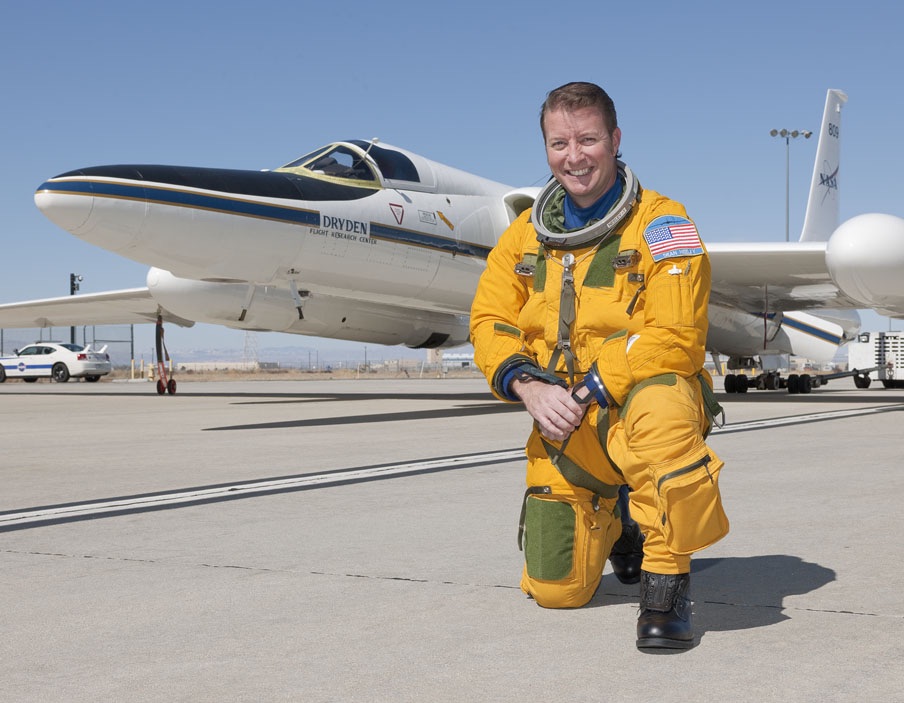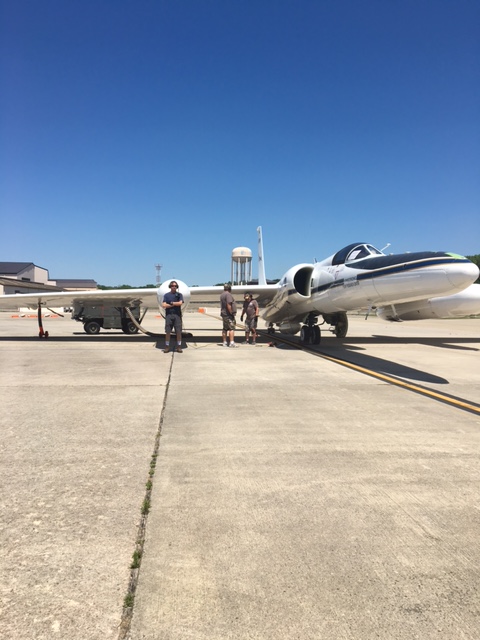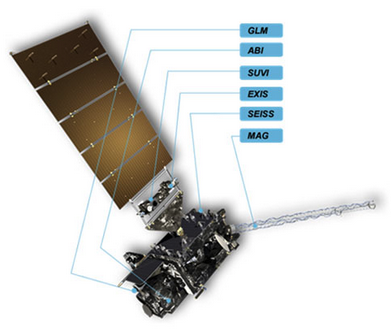
NASA Research Pilot Dean Neeley in front of an ER-2—the type of airplane used in the field campaign to help calibrate instruments on the GOES-16 weather satellite. Image credit: NASA
Wild Weather Jobs: NASA Research Pilot
Weather satellites like GOES-16, short for Geostationary Operational Environmental Satellite-16, carry lots of instruments that monitor Earth’s weather. However, once those satellites are thousands of miles above Earth, how do we know that all of those instruments are working properly?
One way to see if things are working properly is to compare a satellite’s measurements with similar measurements collected in a very high-altitude airplane. Only a handful of pilots in the country are qualified to fly these special planes, and Dean Neeley is one of them. Read on to find out more about his exciting career!
Inspired to Fly
Neeley is a NASA Research Pilot at the NASA Armstrong Flight Research Center in Palmdale, California. He’s been flying planes for decades, but he didn’t always know that he wanted to be a pilot. In fact, he didn’t really become interested in flying planes until college.
“I was studying aerospace engineering at Texas A&M University when I became interested in flying,” Neeley says. “Then I decided to join the US Air Force, where I flew a variety of jets for 25 years. After my military flying career, I was fortunate enough to be hired into my current aerospace engineering and research pilot position with NASA.”
A Typical Day

The ground crew stands with the NASA ER-2 airplane during the GOES-16 field campaign. Image credit: NASA
As a research pilot, there isn’t really a “typical day,” Neeley explains. For his job, he has to fly multiple types of airplanes, so each day is different and exciting, he says. “I fly a variety of planes for NASA including a small motorglider, a business jet, and the 747 which I’m flying to New Zealand today for an astronomy project.”
During a test of the instruments on the GOES-16 weather satellite, Neeley got to fly his favorite aircraft: a plane called the ER-2. The ER-2 flies at very high altitudes from 60,000 feet to 70,000+ feet, which is above 99 percent of the Earth's atmosphere. Neeley is one of only four NASA pilots qualified to fly this airplane.
“My favorite is flying the ER-2. You’re up there alone, far above all other aircraft in the world and it’s very exciting. It’s the most challenging part of the job because it’s difficult to fly an unstable aircraft while wearing a space suit,” he says. “But the challenge is very rewarding.”

The GOES-16 satellite has six science instruments. During the field campaign, nine instruments were flown on Neeley's ER-2 airplane. The instruments collected information used to validate the Earth-viewing GOES-16 imager and lightning mapper. The data collected were used to help validate the performance of the Earth-viewing instruments necessary to the satellite's operation. Image credit: NOAA
Comparing Notes With a Satellite
After weather satellites launch, they have to go through a testing period before they can begin their work. Neeley’s flight was part of this testing, called a field campaign.
During the GOES-16 field campaign, well-characterized and calibrated instruments were flown on an ER-2 airplane over the United States. These instruments took measurements of Earth’s atmosphere looking beneath the airplane while the instruments on GOES-16 took similar measurements from orbit. At the same time, scientists were also collecting related measurements from the ground.
Scientists compared the information collected in the instruments on the airplane with information collected by the satellite and on the ground. They then noted the similarities and differences between the sets of information. This helped the scientists validate the accuracy and precision of GOES-16 measurements so they could make any needed adjustments.
Since GOES-16 is already in orbit around Earth, no one can physically adjust the instruments. Instead, the adjustments are sent as commands from computers on Earth to the satellite in space. The commands help the satellite’s instruments to accurately study the weather and other environmental factors observed by GOES-16.
Tips for Becoming a Research Pilot
Neeley says that young people who are interested in becoming research pilots shouldn’t feel too much pressure to check all of the boxes. “Middle school and high school are challenging times for young people trying to decide what they might be interested in for a future career. I had no idea what I wanted to do at that age, so they shouldn’t worry,” he says.
He recommends studying math and science in school, but he also says it’s important to take some time thinking about different topics that are interesting. “Exploring information when you don’t have to for school is great, and you might find something you want to pursue, like flying. Don’t be afraid to try something different. Explore,” he says.




